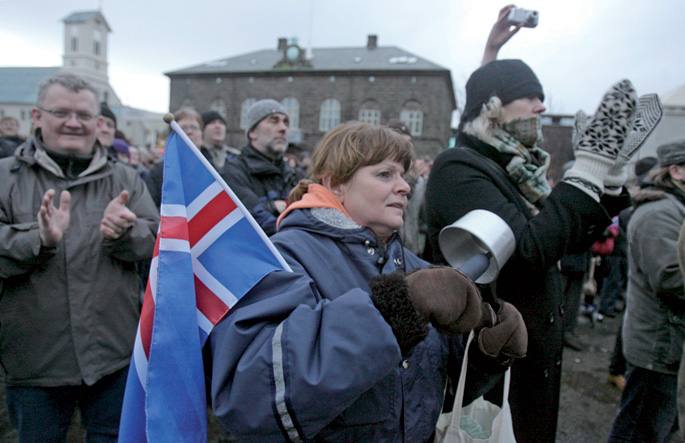

Source: Living in debt
The roots of the economic crisis in Iceland and Ireland are in a mold, but the solutions are very different. The popular revolt in Iceland has led to the non-payment of part of the debt, while in Ireland there has been little mobilisation and the government has approved the economic adjustment imposed by the EU. The following two examples are translated from the first chapter of the book Living in debt, ocracy, Icaria-Asaco (Deudrazian lives), which very briefly describes the debt situation of several European states and is written by Griselda Piñero, Olivier Chantry and Iolanda Fresnillo.
Iceland, MDF arrived, but people don't want to pay for banks
The three major Icesave banks in Iceland (Kaupething, Glitnir and, above all, Landsbanki, via their subsidiary Icesave) were privatised in 2003 and acted intensively in the field of big finance, notably by creating highly speculative funds. With the outbreak of the 2008 crisis, Icelandic banks plunged into the Asian country. And five years after the privatization of their banks, the Icelandic Government had to re-nationalize them. The process is very clear: Before 2003, these banks had to privatize themselves for their huge profits, but since they fell bankrupt the state absorbed them, making their debts take over as well, and in 2008 those debts were ten times higher than the country's GDP. In other words, he nationalized private debts. And for that he was indebted to the International Monetary Fund. On 4 October 2008, the IMF announced a rescue plan – a $2.1 billion loan – and an “acceleration programme” of the Icelandic economy, which promised very harsh austerity measures against social protection and pensions, leading to the closure of hospitals, for example.
At the same time, the British and Dutch governments holding accounts in the Icesav banks, in particular, compensated their citizens, and then transferred the result of the operation to Iceland: EUR 3,900 million. At the end of 2009, the Icesave Parliament passed the Icesave Act, which recognises the obligation to pay that debt to the United Kingdom and the Netherlands. But the major mobilisations achieved a binding referendum with this law, and on 6 March 2010 93% of the Icelanders fell the law. The Icelandic Government signed a new agreement with London and The Hague, which was once again rejected in a referendum held on 11 April 2011. Citizens have refused to pay the debts of banks that had previously been enriched.
The country did not pay Icesav's debts, but has been under IMF adjustment until August 20112. Despite the still high unemployment and slow economic acceleration, the IMF believes that the adjustment programme imposed on Iceland has been a success. It does not take into account, however, that if Iceland has improved not by following its recommendations, but by rejecting part of the debt, causing capital control and currency depreciation, all in a direction contrary to the neoliberal dogma of the IMF.
The sinking of the Celtic Tiger or the defeat of neoliberalism in Ireland
Ireland, “Tigre Zelta”, symbol of the most fierce advocates of neo-liberalism, based its economic growth on tax cuts to attract businesses. Foreign investment ended unemployment and reached a 0% deficit in 2007. Public money accounts were healthy, but they were hidden behind the stock exchanges, banks and housing areas. The growth of bank liquidity facilitated the lack of credit to families, especially for the purchase of housing. In this way, a large housing bubble was financed, which would become the most important engine of the economy.
The explosion of the financial crisis of 2008 led to the dismantling of property and financial bubbles, which led to the collapse of the air castle. Companies closed their doors or left the country, unemployment rose in March (from 0% in 2008 to 14% in early 2010). Difficulties in paying families increased enormously (on the eve of the crisis, the level of household indebtedness was 90 per cent of GDP). In order to avoid the failure of the banking system, the government secured all bank deposits, i.e. EUR 480,000 million (three times the Irish GDP). The government nationalized Allied Irish Bank, which focused on financing the real estate bubble, injecting in it 48,000 euros (about 30% of GDP). With the fall in investments and imports, the reduction in tax revenues and the increase in spending on bank bailouts, the deficit increased from 14% in 2009 to 32% in 2010. This situation forced the Irish Government to stick to the EU guidelines and, as a result, accepted a loan of EUR 85,000 million granted by the EU itself and the IMF, but this money was mainly for the rescue of the financial system and not for the country’s needs. The “aid” provided was accompanied by an austerity plan that targeted basic social services and reduced the purchasing power of consumption (reduced salaries and social services, and increased VAT by up to 21%), reducing consumption and slowing down the economy. The first citizen audit on Zorrarri showed that in 2007 it grew from EUR 20 billion at the end of the 1980s to EUR 40 billion, and has since reached EUR 91 billion, mainly through the financing of private debt.
It is important to note that these ‘aids’ of three NDT, EU and ECB are loans and are offered at a high interest rate. In the case of Ireland, the interest rate was 7% for IMF loans and 6.05% for European loans.
---------------------------------------------------------------------------------------------------------------------
1. At present, the governments of the Netherlands and the United Kingdom want to recover these fortunes by appealing to the courts, while threatening to close the EU door.
2. Paul Krugman, “Iceland Exits”, 1 September 2011 http://krugman.blogs.nytimes.com.